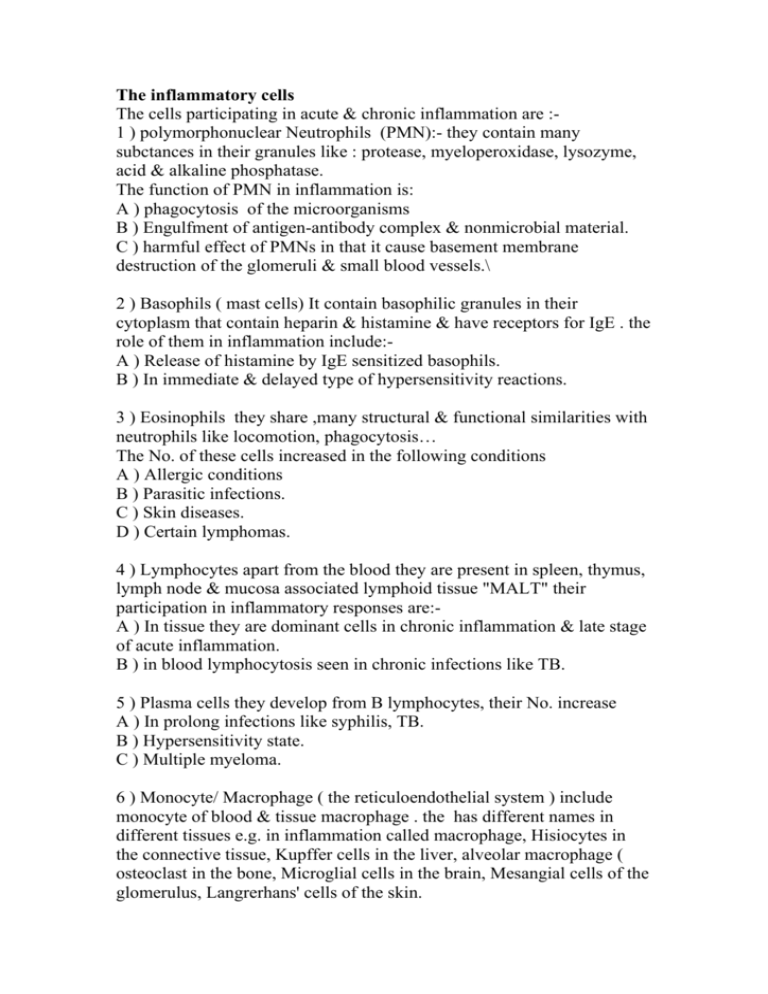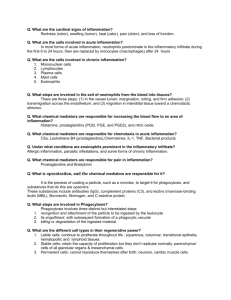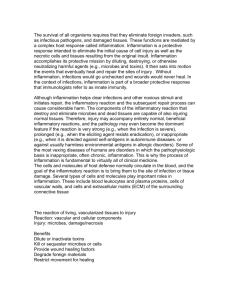The inflammatory cells The cells participating in acute & chronic
advertisement

The inflammatory cells The cells participating in acute & chronic inflammation are :1 ) polymorphonuclear Neutrophils (PMN):- they contain many subctances in their granules like : protease, myeloperoxidase, lysozyme, acid & alkaline phosphatase. The function of PMN in inflammation is: A ) phagocytosis of the microorganisms B ) Engulfment of antigen-antibody complex & nonmicrobial material. C ) harmful effect of PMNs in that it cause basement membrane destruction of the glomeruli & small blood vessels.\ 2 ) Basophils ( mast cells) It contain basophilic granules in their cytoplasm that contain heparin & histamine & have receptors for IgE . the role of them in inflammation include:A ) Release of histamine by IgE sensitized basophils. B ) In immediate & delayed type of hypersensitivity reactions. 3 ) Eosinophils they share ,many structural & functional similarities with neutrophils like locomotion, phagocytosis… The No. of these cells increased in the following conditions A ) Allergic conditions B ) Parasitic infections. C ) Skin diseases. D ) Certain lymphomas. 4 ) Lymphocytes apart from the blood they are present in spleen, thymus, lymph node & mucosa associated lymphoid tissue "MALT" their participation in inflammatory responses are:A ) In tissue they are dominant cells in chronic inflammation & late stage of acute inflammation. B ) in blood lymphocytosis seen in chronic infections like TB. 5 ) Plasma cells they develop from B lymphocytes, their No. increase A ) In prolong infections like syphilis, TB. B ) Hypersensitivity state. C ) Multiple myeloma. 6 ) Monocyte/ Macrophage ( the reticuloendothelial system ) include monocyte of blood & tissue macrophage . the has different names in different tissues e.g. in inflammation called macrophage, Hisiocytes in the connective tissue, Kupffer cells in the liver, alveolar macrophage ( osteoclast in the bone, Microglial cells in the brain, Mesangial cells of the glomerulus, Langrerhans' cells of the skin. Role of macrophage in inflammation include:A ) Phagocytosis B ) activated macrophage release many substances include:1- Protease like collagenase, elastase … 2- Plasminogen activator which activate fIbrinolytic system. 3- Products of complement. 4- Coagulation factors like factor V 5- Chemotactic agents for other leukocytes. 6- Metabolites of archidonic acid. 7- Growth factors for fibroblast & blood vessels. 8- Cytokines like IL-1 & TNF 9- Oxygen derived free radicals. 7 ) Giant cells:- In chronic inflammation when the macrophages fail to deal with particles to be removed they fuse together forming multinucleated giant cells, the commonest giant cells include :1- Langhans' giant cell seen in TB & Sarcoidosis the nuclei are arranged around the periphery in form of horse shoe or ring or clustered at the 2 poles of giant cell. 2- Forign body giant cells may contain up to 100 nuclei which scattered throughout the cytoplasm seen in leprosy. 3- Touton giant cells has vacuolated cytoplasm due to lipid content e.g. xanthoma. In addition to inflammation certain tumors show giant cells like R_S cells in Hodgkins' lymphoma & giant cell tumors of the bone . MORPHOLOGIC PATTERNS OF ACUTE INFLAMMATION The basic morphology of acute inflammation depends on:1- The severity of the inflammatory response. 2- Its specific cause. 3- The particular tissue. There are 4 distinct morphological patterns for acute inflammation these are:1-Serous inflammation is characterized by the outpouring of a watery, relatively protein-poor fluid that derives either from the serum or from the secretions of mesothelial cells lining the peritoneal, pleural, and pericardial cavities "effusion". Other e.g. skin blister resulting from a burn or viral infection in which serous effusion accumulated either within or immediately beneath the epidermis of the skin. 2- Fibrinous inflammation occurs as a consequence of more severe injuries, resulting in greater vascular permeability that allows large molecules (such as fibrinogen) to pass the endothelial barrier. Histologically, the accumulated extravascular fibrin appears as an eosinophilic meshwork of threads or sometimes as an amorphous coagulum . A fibrinous exudate is characteristic of inflammation in the lining of body cavities, such as the meninges, pericardium, and pleura. Such exudates may be degraded by fibrinolysis, and the accumulated debris may be removed by macrophages, resulting in restoration of the normal tissue structure (resolution). However, failure to completely remove the fibrin results in the ingrowth of fibroblasts and blood vessels (organization), leading ultimately to scarring that may have significant clinical consequences. 3- Supportive (purulent) inflammation is manifested by the presence of large amounts of purulent exudate (pus) consisting of neutrophils, necrotic cells, and edema fluid. Certain organisms (e.g., staphylococci) are more likely to induce such localized suppuration and are therefore referred to as pyogenic. Abscesses are focal collections of pus that may be caused by seeding of pyogenic organisms into a tissue or by secondary infections of necrotic foci. Abscesses typically have a central, largely necrotic region rimmed by a layer of preserved neutrophils , with a surrounding zone of dilated vessels and fibroblastic proliferation indicative of early repair. As time passes the abscess may become completely walled off and eventually be replaced by connective tissue. 4-Ulceration: - An ulcer is a local defect, or excavation, of the surface of an organ or tissue that is produced by necrosis of cells and sloughing (shedding) of inflammatory necrotic tissue . Ulceration can occur only when tissue necrosis and resultant inflammation exist on or near a surface. It is most commonly encountered in Inflammatory necrosis of the mucosa of the mouth, stomach, intestines, or genitourinary tract. Ulcerations are best exemplified by peptic ulcer of the stomach or duodenum, in which acute and chronic inflammation coexist. SYSTEMIC EFFECTS OF INFLAMMATION The systemic effects of inflammation, collectively called the acute-phase reaction. The cytokines TNF, IL-1, and IL-6 are the most important mediators of the acute-phase reaction. These cytokines are produced by leukocytes (and other cell types) in response to infection or in immune reactions and are released systemically. The acute-phase response consists of several clinical and pathologic changes. 1-Fever, is one of the most prominent manifestations of the acute-phase response, especially when inflammation is caused by infection. Fever is produced in response to substances called pyrogens that act by stimulating prostaglandin (PG) synthesis in the hypothalamus. Bacterial products, such as lipopolysaccharide (LPS; called exogenous pyrogens), stimulate leukocytes to release cytokines such as IL-1 and TNF (called endogenous pyrogens) that increase the levels of cyclooxygenases that convert AA into prostaglandins. In the hypothalamus the PGs, especially PGE2, stimulate the production of neurotransmitters, which function to reset the temperature set point at a higher level. NSAIDs, , reduce fever by inhibiting cyclooxygenase and thus blocking PG synthesis.. 2-Elevated plasma levels of acute-phase proteins, which are plasma proteins, mostly synthesized in the liver, whose concentrations may increase several 100-fold as part of the response to inflammatory stimuli. Three of the best-known of these proteins are C-reactive protein (CRP), fibrinogen, and serum amyloid A (SAA) protein. Synthesis of these molecules by hepatocytes is up-regulated by cytokines, especially IL-6. Many acute-phase proteins, such as CRP and SAA, bind to microbial cell walls, and they may act as opsonins and fix complement, thus promoting the elimination of the microbes. Fibrinogen binds to erythrocytes and causes them to form stacks (rouleaux) that sediment more rapidly at unit gravity than do individual erythrocytes. This is the basis for measuring the erythrocyte sedimentation rate (ESR) as a simple test for the systemic inflammatory response, caused by any number of stimuli, including LPS. Elevated serum levels of CRP are now used as a marker for increased risk of myocardial infarction or stroke in patients with atherosclerotic vascular disease. It is believed that inflammation is involved in the development of atherosclerosis, and increased CRP is a measure of inflammation. 3-Leukocytosis is a common feature of inflammatory reactions, especially those induced by bacterial infection. The leukocyte count usually climbs to 15,000 or 20,000 cells/μL, but sometimes it may reach extraordinarily high levels, as high as 40,000 to 100,000 cells/μL. These extreme elevations are referred to as leukemoid reactions because they are similar to leukemia. The leukocytosis occurs initially because of accelerated release of cells from the bone marrow and is therefore associated with a rise in the number of more immature neutrophils in the blood (shift to the left). Prolonged infection also stimulates production of colony-stimulating factors (CSFs), leading to increased bone marrow output of leukocytes, which compensates for the loss of these cells in the inflammatory reaction. Most bacterial infections induce an increase in the blood neutrophil count, called neutrophilia. Viral infections, such as infectious mononucleosis, mumps, and German measles, are associated with increased numbers of lymphocytes (lymphocytosis). Bronchial asthma, hay fever, and parasite infestations all involve an increase in the absolute number of eosinophils, creating an eosinophilia. Certain infections (typhoid fever and infections caused by some viruses, rickettsiae, and certain protozoa) are paradoxically associated with a decreased number of circulating white cells (leukopenia), likely because of cytokine-induced sequestration of lymphocytes in lymph nodes. 4-Other manifestations of the acute-phase response include increased heart rate and blood pressure; decreased sweating, mainly because of redirection of blood flow from cutaneous to deep vascular beds, to minimize heat loss through the skin; and rigors (shivering), chills (perception of being cold as the hypothalamus resets the body temperature), anorexia, somnolence, and malaise, probably because of the actions of cytokines on brain cells. Chronic inflammation is associated with a wasting syndrome called cachexia, which is mainly the result of TNF-mediated appetite suppression and mobilization of fat stores. Factors determining variation in inflammatory response The variation in inflammatory response depend on number of factors & processes:1- Factors involving the organisms A) Type of injury & infection e.g lung react to TB by forming granuloma while to pneumococci by lobar pneumonia. B) Virulence e.g the 3 strains of diphtheria [produce the same exotoxins but in different amount. C) Dose the concentration of organisms is important factor to determine the extent of lesion i.e local or systemic. D) Port of entery vibrio cholera is not pathogenic if injected subcutaneously but may cause death if swallowed. E) Products of the organism some M.O. produce enzymes that help in spread of infection e.g streptokinase by streptococci. 2- Factors involving the host A) Systemic diseases e.g. DM, chronic renal failure, liver cirrhosis, B) Immune status of the host patient with AIDS have lower inflammatory response also those with congenital neutrophil defects. C) Type of tissue : the reaction of bone to inflammation is differ from that of lung . D) Leukopenia E) Local host factors e.g Forign Body, chemicals, ischemia.








